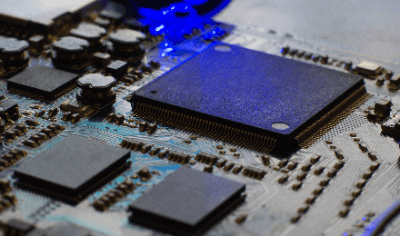What Is an SoC?

An SoC (system on chip) is a single integrated circuit that integrates multiple system functions.
Unlike conventional system designs that utilize multiple chips (such as microprocessors, memory, graphics devices, communication devices, etc.), an SoC combines these functions onto a single chip, resulting in a compact and high-performance system.
Uses of SoCs
SoCs are used in diverse applications, including smartphones, tablets, embedded systems, IoT devices, and automobiles. These chips serve as the central component in device control, enhancing multifunctionality and miniaturization.
1. Mobile Devices
SoCs are fundamental in mobile devices like smartphones and tablets, integrating various functions such as processing, graphics, memory, communication, and sensors onto a single chip.
2. Embedded Systems
Embedded systems across various sectors, including automotive, home appliances, industrial controls, and medical equipment, employ SoCs for their advanced functions and real-time processing capabilities.
3. IoT (Internet of Things) Devices
In IoT devices, SoCs provide critical functions such as sensing, communication, and data processing, offering advanced functionality and connectivity with minimal power consumption. This includes smart home devices, sensor nodes, and wearable technology.
4. Network Devices
Network devices, including routers, switches, and network security equipment, rely on SoCs for high-speed data processing and communication functions.
5. Audio/Visual Equipment
SoCs are also prevalent in audio/visual equipment like televisions, audio systems, and digital cameras, integrating various functions such as video and audio processing, and interfaces on a single chip.
6. Automotive Systems
In the automotive industry, SoCs are essential for in-vehicle systems, managing functions like vehicle control, driver assistance, entertainment, and communications to enhance comfort and safety.
Principle of SoCs
An SoC integrates all necessary functions into a single integrated circuit. Design data for each function is available either for free or at a cost. By selecting and connecting these functions using design tools, integrated circuits with desired functionalities are created. Circuit blocks available for integration include:
1. Microprocessor
Most SoCs include a microprocessor (CPU), enabling various functions through software.
2. Memory Devices
Memory devices are incorporated for CPU usage, including cache memory, RAM, and ROM, mainly for data and program storage.
3. Graphics Processing Devices
Graphics processing capabilities may be included, facilitating advanced graphics display, such as video playback, image processing, and 3D graphics.
4. Input/Output Interface
Various interfaces for connecting to external devices, such as USB, HDMI, Ethernet, and Wi-Fi, are provided.
5. Communication Functions
Communication functions supporting various protocols (e.g., Bluetooth, NFC, LTE) are often included for network connectivity and data transmission.
6. Sensor Signal Processing
SoCs may incorporate circuits for handling analog signals from devices like accelerometers, gyroscopes, and optical sensors, as well as A/D converters for digital data conversion.
The integration of these devices onto a single chip enables high-performance systems that are space-efficient and consume less power.
Other Information on SoCs
Development Process of SoC
The SoC development process involves several stages:
1. Function Selection and Design
The initial step is selecting the required functions and defining design specifications, including processors, memory, interfaces, network functions, and sensors.
2. Hardware Design
This stage entails designing specific circuits like digital circuits, analog circuits, memory blocks, and interface circuits, using techniques like schematics, flowcharts, and HDL (Hardware Description Language).
3. Chip Integration and Placement
After circuit design, hardware blocks are placed on a chip, including circuit interconnections, signal routing, and power routing. Advanced automated design tools are often used for efficient and reliable chip layouts.
4. Device Manufacturing
This involves semiconductor wafer fabrication, transistor, and circuit formation, and interconnect layer creation, culminating in the manufacturing and packaging of the IC chip.
5. Software Development
SoC development includes software creation, such as firmware, drivers, and application software, to complement the hardware functionalities.
6. Verification and Testing
The final stage involves verifying and testing the SoC, including circuit operation, signal accuracy, and system-level testing, to ensure quality and reliability.
These processes result in an SoC that integrates multiple functionalities into a single chip, achieving advanced system capabilities.